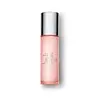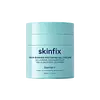ReVive Skincare Fermitif™ Neck Renewal Serum Firming Treatment Versus Skinfix Barrier+ Skin Barrier Restoring Gel Cream
What's inside
What's inside
 Key Ingredients
Key Ingredients

 Benefits
Benefits

 Concerns
Concerns

No concerns
 Ingredients Side-by-side
Ingredients Side-by-side

Water
Skin ConditioningGlycerin
HumectantNiacinamide
SmoothingBiosaccharide Gum-4
Skin ConditioningCocoglycerides
EmollientPropanediol
SolventIsododecane
EmollientPentylene Glycol
Skin ConditioningDimethicone
Emollient3-O-Ethyl Ascorbic Acid
Skin ConditioningOligopeptide-20
Skin ConditioningAcetyl Hexapeptide-8
HumectantOligopeptide-24
Skin ConditioningPentapeptide-4
Skin ConditioningHeptapeptide-15 Palmitate
Skin ConditioningD-Arginyl Tyrosinyl Ornithinyl Phenylalanine
Skin ConditioningCopper Heptapeptide-14 Pantothenate
Skin ConditioningCaesalpinia Spinosa Fruit Extract
Skin ProtectingTocopherol
AntioxidantGlycyrrhiza Glabra Root Extract
BleachingCamellia Sinensis Leaf Extract
AntimicrobialAvena Sativa Kernel Oil
Skin ConditioningAllantoin
Skin ConditioningKappaphycus Alvarezii Extract
Skin ConditioningTocopheryl Acetate
AntioxidantAlgin
MaskingPichia Ferment Lysate Filtrate
HumectantAlpha-Glucan Oligosaccharide
CleansingPullulan
Hydrolyzed Jojoba Esters
Skin ConditioningSodium Oleate
CleansingGlycine Soja Oil
EmollientHydrogenated Lecithin
EmulsifyingParfum
MaskingLactic Acid/Glycolic Acid Copolymer
Skin ConditioningHydrogenated Phosphatidylcholine
EmulsifyingUbiquinone
AntioxidantDextran
Acrylates/Dimethicone Copolymer
Skin ConditioningEthylhexylglycerin
Skin ConditioningAcrylates/C10-30 Alkyl Acrylate Crosspolymer
Emulsion StabilisingMaltodextrin
AbsorbentPhenoxyethanol
PreservativePotassium Hydroxide
BufferingSodium Stearoyl Glutamate
CleansingSodium Phytate
Disodium EDTA
Potassium Sorbate
PreservativePolyvinyl Alcohol
Water, Glycerin, Niacinamide, Biosaccharide Gum-4, Cocoglycerides, Propanediol, Isododecane, Pentylene Glycol, Dimethicone, 3-O-Ethyl Ascorbic Acid, Oligopeptide-20, Acetyl Hexapeptide-8, Oligopeptide-24, Pentapeptide-4, Heptapeptide-15 Palmitate, D-Arginyl Tyrosinyl Ornithinyl Phenylalanine, Copper Heptapeptide-14 Pantothenate, Caesalpinia Spinosa Fruit Extract, Tocopherol, Glycyrrhiza Glabra Root Extract, Camellia Sinensis Leaf Extract, Avena Sativa Kernel Oil, Allantoin, Kappaphycus Alvarezii Extract, Tocopheryl Acetate, Algin, Pichia Ferment Lysate Filtrate, Alpha-Glucan Oligosaccharide, Pullulan, Hydrolyzed Jojoba Esters, Sodium Oleate, Glycine Soja Oil, Hydrogenated Lecithin, Parfum, Lactic Acid/Glycolic Acid Copolymer, Hydrogenated Phosphatidylcholine, Ubiquinone, Dextran, Acrylates/Dimethicone Copolymer, Ethylhexylglycerin, Acrylates/C10-30 Alkyl Acrylate Crosspolymer, Maltodextrin, Phenoxyethanol, Potassium Hydroxide, Sodium Stearoyl Glutamate, Sodium Phytate, Disodium EDTA, Potassium Sorbate, Polyvinyl Alcohol
Water
Skin ConditioningSqualane
EmollientPropanediol
SolventJojoba Oil/Macadamia Seed Oil Esters
Skin ConditioningTriheptanoin
Skin ConditioningNiacinamide
SmoothingSaccharide Isomerate
HumectantAmmonium Acryloyldimethyltaurate/Vp Copolymer
Squalene
EmollientZinc PCA
HumectantHydrolyzed Hyaluronic Acid
HumectantGlycerin
HumectantCamellia Sinensis Seed Extract
HumectantAllantoin
Skin ConditioningPhytosteryl Macadamiate
Skin ConditioningPhytosterols
Skin ConditioningAcetyl Glutamine
Skin ConditioningLecithin
EmollientCaprylyl Glycol
EmollientAmylopectin
Sodium Hyaluronate
HumectantFolic Acid
Skin ConditioningOligopeptide-3
Skin ConditioningBacillus/Soybean Ferment Extract
Skin ConditioningOligopeptide-1
Skin ConditioningOligopeptide-2
Skin ConditioningHexapeptide-11
Skin ConditioningTocopherol
AntioxidantLithothamnion Calcareum Extract
Skin ConditioningLactic Acid
BufferingGlucose
HumectantAcetyl Heptapeptide-4
HumectantC14-22 Alcohols
Emulsion StabilisingC12-20 Alkyl Glucoside
EmulsifyingEthylhexylglycerin
Skin ConditioningTrisodium Ethylenediamine Disuccinate
Potassium Sorbate
PreservativeCitric Acid
BufferingSodium Citrate
BufferingPentylene Glycol
Skin ConditioningSodium Benzoate
MaskingXanthan Gum
EmulsifyingPhenoxyethanol
PreservativeWater, Squalane, Propanediol, Jojoba Oil/Macadamia Seed Oil Esters, Triheptanoin, Niacinamide, Saccharide Isomerate, Ammonium Acryloyldimethyltaurate/Vp Copolymer, Squalene, Zinc PCA, Hydrolyzed Hyaluronic Acid, Glycerin, Camellia Sinensis Seed Extract, Allantoin, Phytosteryl Macadamiate, Phytosterols, Acetyl Glutamine, Lecithin, Caprylyl Glycol, Amylopectin, Sodium Hyaluronate, Folic Acid, Oligopeptide-3, Bacillus/Soybean Ferment Extract, Oligopeptide-1, Oligopeptide-2, Hexapeptide-11, Tocopherol, Lithothamnion Calcareum Extract, Lactic Acid, Glucose, Acetyl Heptapeptide-4, C14-22 Alcohols, C12-20 Alkyl Glucoside, Ethylhexylglycerin, Trisodium Ethylenediamine Disuccinate, Potassium Sorbate, Citric Acid, Sodium Citrate, Pentylene Glycol, Sodium Benzoate, Xanthan Gum, Phenoxyethanol
 Reviews
Reviews

Ingredients Explained
These ingredients are found in both products.
Ingredients higher up in an ingredient list are typically present in a larger amount.
Allantoin is a soothing ingredient known for its protective and moisturizingg properties. Because of this, it is often added to products with strong active ingredients.
Studies show higher concentrations of this ingredient can promote wound healing.
Though it can be derived from the comfrey plant, allantoin is produced synthetically for cosmetic products to ensure purity.
Learn more about AllantoinEthylhexylglycerin (we can't pronounce this either) is commonly used as a preservative and skin softener. It is derived from glyceryl.
You might see Ethylhexylglycerin often paired with other preservatives such as phenoxyethanol. Ethylhexylglycerin has been found to increase the effectiveness of these other preservatives.
Glycerin is already naturally found in your skin. It helps moisturize and protect your skin.
A study from 2016 found glycerin to be more effective as a humectant than AHAs and hyaluronic acid.
As a humectant, it helps the skin stay hydrated by pulling moisture to your skin. The low molecular weight of glycerin allows it to pull moisture into the deeper layers of your skin.
Hydrated skin improves your skin barrier; Your skin barrier helps protect against irritants and bacteria.
Glycerin has also been found to have antimicrobial and antiviral properties. Due to these properties, glycerin is often used in wound and burn treatments.
In cosmetics, glycerin is usually derived from plants such as soybean or palm. However, it can also be sourced from animals, such as tallow or animal fat.
This ingredient is organic, colorless, odorless, and non-toxic.
Glycerin is the name for this ingredient in American English. British English uses Glycerol/Glycerine.
Learn more about GlycerinNiacinamide is a multitasking form of vitamin B3 that strengthens the skin barrier, reduces pores and dark spots, regulates oil, and improves signs of aging.
And the best part? It's gentle and well-tolerated by most skin types, including sensitive and reactive skin.
You might have heard of "niacin flush", or the reddening of skin that causes itchiness. Niacinamide has not been found to cause this.
In very rare cases, some individuals may not be able to tolerate niacinamide at all or experience an allergic reaction to it.
If you are experiencing flaking, irritation, and dryness with this ingredient, be sure to double check all your products as this ingredient can be found in all categories of skincare.
When incorporating niacinamide into your routine, look out for concentration amounts. Typically, 5% niacinamide provides benefits such as fading dark spots. However, if you have sensitive skin, it is better to begin with a smaller concentration.
When you apply niacinamide to your skin, your body converts it into nicotinamide adenine dinucleotide (NAD). NAD is an essential coenzyme that is already found in your cells as "fuel" and powers countless biological processes.
In your skin, NAD helps repair cell damage, produce new healthy cells, support collagen production, strengthen the skin barrier, and fight environmental stressors (like UV and pollution).
Our natural NAD levels start to decline with age, leading to slower skin repair, visible aging, and a weaker skin barrier. By providing your skin niacinamide, you're recharging your skin's NAD levels. This leads to stronger, healthier, and younger looking skin.
Another name for vitamin B3 is nicotinamide. This vitamin is water-soluble and our bodies don't store it. We obtain Vitamin B3 from either food or skincare. Meat, fish, wheat, yeast, and leafy greens contain vitamin B3.
The type of niacinamide used in skincare is synthetically created.
Learn more about NiacinamidePentylene glycol is typically used within a product to thicken it. It also adds a smooth, soft, and moisturizing feel to the product. It is naturally found in plants such as sugar beets.
The hydrophilic trait of Pentylene Glycol makes it a humectant. As a humectant, Pentylene Glycol helps draw moisture from the air to your skin. This can help keep your skin hydrated.
This property also makes Pentylene Glycol a great texture enhancer. It can also help thicken or stabilize a product.
Pentylene Glycol also acts as a mild preservative and helps to keep a product microbe-free.
Some people may experience mild eye and skin irritation from Pentylene Glycol. We always recommend speaking with a professional about using this ingredient in your routine.
Pentylene Glycol has a low molecular weight and is part of the 1,2-glycol family.
Learn more about Pentylene GlycolPhenoxyethanol is a preservative that has germicide, antimicrobial, and aromatic properties. Studies show that phenoxyethanol can prevent microbial growth. By itself, it has a scent that is similar to that of a rose.
It's often used in formulations along with Caprylyl Glycol to preserve the shelf life of products.
Potassium Sorbate is a preservative used to prevent yeast and mold in products. It is commonly found in both cosmetic and food products.
This ingredient comes from potassium salt derived from sorbic acid. Sorbic acid is a natural antibiotic and effective against fungus.
Both potassium sorbate and sorbic acid can be found in baked goods, cheeses, dried meats, dried fruit, ice cream, pickles, wine, yogurt, and more.
You'll often find this ingredient used with other preservatives.
Learn more about Potassium SorbatePropanediol is an all-star ingredient. It softens, hydrates, and smooths the skin.
It’s often used to:
Propanediol is not likely to cause sensitivity and considered safe to use. It is derived from corn or petroleum with a clear color and no scent.
Learn more about PropanediolTocopherol (also known as Vitamin E) is a common antioxidant used to help protect the skin from free-radicals and strengthen the skin barrier. It's also fat soluble - this means our skin is great at absorbing it.
Vitamin E also helps keep your natural skin lipids healthy. Your lipid skin barrier naturally consists of lipids, ceramides, and fatty acids. Vitamin E offers extra protection for your skin’s lipid barrier, keeping your skin healthy and nourished.
Another benefit is a bit of UV protection. Vitamin E helps reduce the damage caused by UVB rays. (It should not replace your sunscreen). Combining it with Vitamin C can decrease sunburned cells and hyperpigmentation after UV exposure.
You might have noticed Vitamin E + C often paired together. This is because it is great at stabilizing Vitamin C. Using the two together helps increase the effectiveness of both ingredients.
There are often claims that Vitamin E can reduce/prevent scarring, but these claims haven't been confirmed by scientific research.
Learn more about TocopherolWater. It's the most common cosmetic ingredient of all. You'll usually see it at the top of ingredient lists, meaning that it makes up the largest part of the product.
So why is it so popular? Water most often acts as a solvent - this means that it helps dissolve other ingredients into the formulation.
You'll also recognize water as that liquid we all need to stay alive. If you see this, drink a glass of water. Stay hydrated!
Learn more about Water